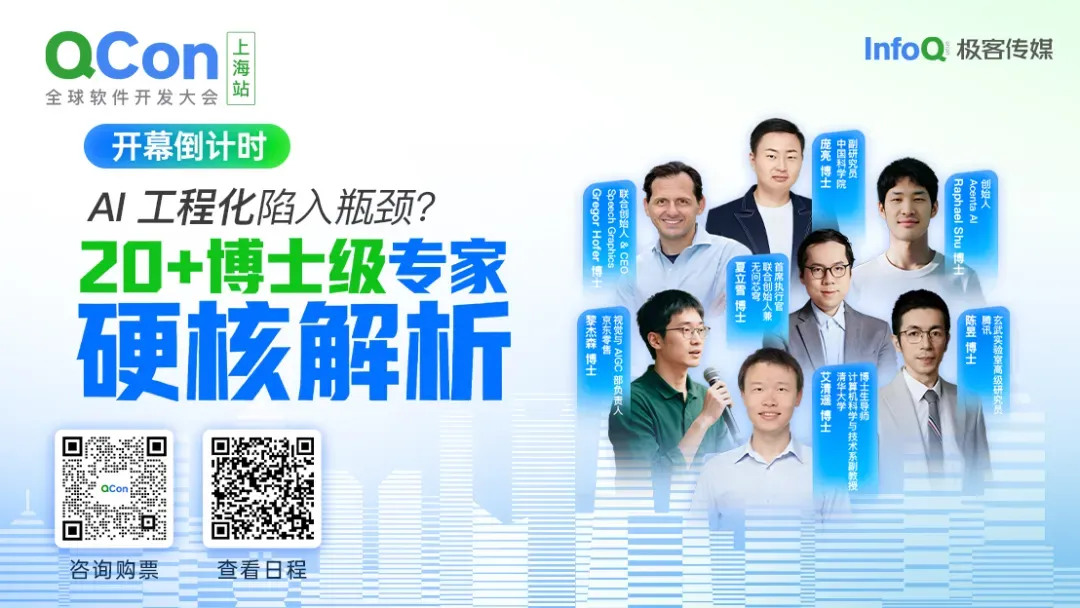# QCon 2025 Beijing Highlights
**Date:** 2025‑10‑15 · **Location:** Beijing
**Theme:** *“Deeply cultivate existing skills, embrace new knowledge.”*


---
## Introduction
In the era of **distributed** and **cloud‑native computing**, middleware shields underlying complexity and provides standardized interfaces, greatly improving development efficiency.
Today, **AI middleware** plays a similar role. But:
- How can we transition from *cloud‑native* to *intelligent‑native* smoothly?
- How can we address key pain points in current AI application development?
Recently, InfoQ’s *Geek Interview* × AICon livestream invited:
- **Song Shun** – Senior Technical Expert, Ant Group
- **Zhang Geng** – Head of AI Middleware, Ant Group
- **Dr. Li Zhiyu** – CTO, Memory Tensor
Ahead of **QCon Global Software Development Conference 2025 Shanghai**, they explored **the infrastructure battle behind AI middleware**.
### Key Insights
- **Lower barriers & improve reliability:** AI middleware reduces entry difficulty, improves system reliability, and keeps applications secure & controllable.
- **In-house development necessity:** Not “reinventing the wheel,” but building a **“super race car”** tailored to your industry, rules, safety, and costs.
- **Strategic use of open source:** Use open source/cloud for exploratory projects; build or customize in-house for core/large-scale apps.
- **Reviving traditional assets:** Older tech isn’t obsolete — it must be reborn in new AI frameworks.
---
## QCon 2025 Shanghai Preview
**Dates:** October 23–25
**Location:** Shanghai
Dedicated Track: **[AI Middleware: Accelerating Intelligent Application Development]**
Focus:
- Core AI middleware technologies
- Industry practices & trends
- Topics: Agent architecture, multimodal collaboration, production deployments
Event Details: [https://qcon.infoq.cn/2025/shanghai/schedule](https://qcon.infoq.cn/2025/shanghai/schedule)
---
## Intelligent Infrastructure
### Cloud-native vs Intelligent-native
**Song Shun:** Cloud-native schedules/manages services — in intelligent-native, will core objects shift to **Agents, models, memories**?
**Zhang Geng:**
- Cloud-native apps: “born in the cloud, grow in the cloud” → microservices, containerization, CI/CD, DevOps → maximize cloud benefits.
- Intelligent-native: maximize AI benefits → rapid LLM invocation, memory services, stable Agents → carrier shifts from microservices to intelligent Agents.
**Key Differences:**
- **Scheduling expansion:** Beyond CPU/memory/network into GPUs, TPUs, heterogeneous computing.
- **New foundational services:** Inference, RAG, memory — delivered as cloud services, spawning new paradigms.
- **State management:** Agents require persistent, contextual memory.
- **Uncertainty challenge:** LLM responses are probabilistic—critical for financial-grade predictability.
---
## Memory as the “Hippocampus” of AI
**Song Shun:** Is memory service fundamental or optional?
**Li Zhiyu:**
- **Human hippocampus:** Translates short-term into long-term memories. Without it → no lasting knowledge.
- AI analogy: Without persistent memory → only short-term exchanges (e.g., ChatGPT’s improvement came from conversation memory).
- **MemOS goal:** Simulate hippocampus → store, recall, learn from past, adapt continuously.
- Position: Today optional; future essential for AI-native apps.
---
## AI Middleware as Connector & Accelerator
### Why Build In-House Middleware?
**Zhang Geng:**
- **Technical:** Unified infrastructure, easy access to core services, integration with thousands of internal RPC queues/interfaces.
- **Security:** Meet strict data privacy/compliance demands.
- **Cost:** Efficiency gains (e.g., halve dev time for apps with tens of millions of users), token cost optimization.
---
## Technical Bottlenecks in AI Memory
**Li Zhiyu:** Beyond retrieval accuracy/speed:
- **System engineering:** Reading, organizing, storing, retrieving, sharing — all require design.
- **Vector DBs:** Common, good for semantics; not complete solution.
- **Future directions:**
1. Hierarchical memory management.
2. Structured/event/context-based organization & extraction.
3. **Human brain inspiration:** Forgetting as optimization → OS-like memory lifecycle management.
---
## Engineering Practices in AI Middleware
**Song Shun:**
- **Challenges:** Context length → solved with layered memory.
- Tool invocation security → sandbox & permission approval.
- Agent unpredictability → simulation-based testing for observability & control.
---
## Future Capabilities & Middleware Roles
**Li Zhiyu & Zhang Geng:**
- If models become cheap/powerful: Basic orchestration replaced; industry/personalization remains.
- Middleware role: Connect **business** and **models**, ensure safety, compliance, process orchestration.
---
## Building Enterprise‑Grade AI Middleware
### Balancing Open Source vs In-House
- **Non-core:** Cloud/open source → fast iteration.
- **Core:** In-house/deep custom → keep control over business lifeline.
- **Protecting moat:**
1. Match business.
2. Optimize performance/cost.
3. Integrate deeply with tech stack.
4. Stay open.
---
## Costs & ROI
- From scratch → huge investment.
- Focused scope → controllable cost.
- **Starts as cost center**, quickly becomes capability/value center.
- ROI:
- Build first → 6–12 months.
- Co-build with business → 3 months visible return.
---
## GPU Optimization Strategies
**Li Zhiyu:**
- Fine-grain scheduling to maximize utilization.
- Unified memory scheduling (parameterized, activation, plaintext).
- Predict user intent & preload → reduce latency.
- KV cache optimizations.
---
## Potential Standards in AI Middleware
**Li Zhiyu:**
- Possible unified standard if framework covers scheduling, interfaces, governance, security.
- Architecture may mimic human brain: memory, reasoning, perception, action.
**Zhang Geng:**
- Likely “sub-domain standards” (e.g., MCP for tool invocation).
- Multimodality & robotics → real-time orchestration, safety redundancy.
---
## Skills for AI Middleware Engineers
### Old Skills (Distributed Systems)
- CAP theorem
- Paxos/Raft
- Service governance
- Monitoring/alerting
- Performance optimization
### New Skills (LLM/Agents)
- Context engineering
- RAG optimization
- Agent orchestration
- Multimodal processing
**Balanced learning path:**
1. Theory.
2. Hands-on projects.
3. Solve real problems.
4. Build reusable components.
---
## Timeless Engineering Principles
- **Engineering methodology** outlasts specific tools.
- Blend old and new skills to stay competitive.
- Start small (RAG/tool Agents), progress to complex memory/context/multi-Agent systems.
---
## Event Recommendation
**QCon Shanghai** · **Oct 23–25**
Three days · 100+ engineering cases · Topics include Agentic AI, Embodied Intelligence, RL, edge‑LLM practice, multi‑Agent collab.

---
**Original Article:** [Read Original](2651258789)
**WeChat Link:** [Open in WeChat](https://wechat2rss.bestblogs.dev/link-proxy/?k=3155a2c6&r=1&u=https%3A%2F%2Fmp.weixin.qq.com%2Fs%3F__biz%3DMjM5MDE0Mjc4MA%3D%3D%26mid%3D2651258789%26idx%3D2%26sn%3D99c9581e0a36f918de867d9840f95211)




